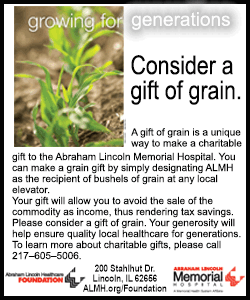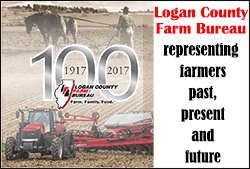|
 The foundation of basis comes from the
mathematical equation of Current Cash Price minus Chicago Board of
Trade (CBOT) commodity futures. The foundation of basis comes from the
mathematical equation of Current Cash Price minus Chicago Board of
Trade (CBOT) commodity futures.
Basis can be reported as strong or weak.
A weak basis is when the above mathematical formula yields a
negative conclusion. A strong basis is when the outcome of the
formula yields a positive conclusion.
Examples: $3.15 – $3.48 = -.35
In this example, the cash price on October 18, 2018 was $3.15 while
the futures price for January 2018 was 3.48. The basis then equaled
-.35 or 35 cents under, a weak basis.
In another example: $3.15 – $2.78 = +.37 equates to the market being
strong. Market experts would refer to this as 37 cents over in their
reports.
But what do the ‘over’ or ‘under’ outcome mean to the farmer?

A weak (under) market is an indicator that the supply versus demand
is telling buyers that there is more product on hand than will be
needed in the near future. Surplus product consequently drives the
cash price down. Many times this figure is driven by a ‘prediction’
of upcoming harvest figures. The futures will stay higher, but can
also drop if and when it is discovered that the prediction was
correct.
If the futures price begins to fall at a rate that exceeds the
decline in the cash price, then market analysts will designate the
scenario as “weak and narrowing.”
A strong (over) market means that future buyers are anticipating
there will be a larger demand for product than sellers can supply in
the immediate future.
Prices quoted on the CBOT are based on points of time in the future,
i.e. the term “futures” is often associated with the CBOT prices. As
the cash price dates draw close to the futures month, the basis
between cash and futures will most often narrow. When the futures
price month changes to another point in the future, the basis will
widen.
For example, in the month of August 2017 the futures price quote was
based on a September end date:
On August 2nd, the Illinois USDA reported the average cash price for
corn at $3.40 with a -.305 basis for September. On August 30th the
basis dropped to -.22 because the date was extremely near the
futures end date.
In start contract, when September rolled around, the futures end
date changed to December and the basis immediately jumped up to
-.375.
There are also other factors that can influence basis that are not
visible in a market report. Supply and demand is simple, but other
factors include storage costs and interest, and transportation
costs. These factors impact regional basis figures, as do
geographical variations.

Basis is figured using CBOT with the cash price at local elevators.
Cash prices in local elevators can vary according to the state and
even the region of the state. For example, the Illinois USDA records
cash prices by regions including Northern, Western, North Central,
South Central, Wabash,
W.S. West, and Little Egypt.
On October 18th, 2017, those prices were reported as below:
Commercial grain prices paid farmers by Interior Illinois Country
Elevators after 2.00 p.m. are listed below in dollars per bushel:
|
AREA |
US 2
CORN |
US 1
SOYBEANS |
US 2
SOFT
WHEAT |
|
NORTHERN |
3.01 - 3.19 |
9.19 - 9.40 |
|
|
WESTERN |
3.01 - 3.10 |
9.22 - 9.39 |
|
|
N. CENT. |
3.08 - 3.22 |
9.39 - 9.54 |
|
|
S. CENTRAL |
3.05 - 3.20 |
9.31 - 9.46 |
|
|
WABASH |
3.14 - 3.23 |
9.33 - 9.46 |
|
|
W.S. WEST |
3.03 - 3.21 |
9.32 - 9.47 |
|
|
L. EGYPT |
3.01 - 3.17 |
9.16 - 9.34 |
|
The cash prices recorded for the Wabash Region had
the highest price range of all. The reason for this is based on
geography as well as regional conditions. The region which borders
the Wabash River and the Indiana State line has seen large amounts
of rain throughout the growing season, rain significant enough to
hinder planting, damage standing crops, and possibly impact the
ability to harvest.
At the same time, the Wabash Region is high in pork production,
meaning there are more producers who will feed their harvest to
livestock, meaning there is possibly less corn for sale at local
elevators, creating a sense that demand in the region outweighs the
supply.

Looking back at the same region on August 2nd, Wabash cash corn was
much higher than it is in October at $3.47 - $3.62. This is
important because, the cash price is dropping as harvest gets
underway; an indication that perhaps crops are yielding better than
originally predicted.
[to top of second column] |

But what did all this mean for the basis? In August
the futures price on the 2nd was $3.71, so the regional basis for
Wabash was only -.24 to -.09 or on the average -.165; very narrow.
On October 18th that basis ‘widened’ from an average of -.165 to an
average of -.295, an indication that supply is approaching demand
within the region.
Generally speaking, any circumstance that impacts the
price of a commodity will also impact the basis. This can be
anything from weather conditions starting right before planting
season all the way through to harvest; availability of
transportation such as trucking, rail car or barge; and the cost of
transportation. Of course yields at harvest impact the price as
well.
Savvy marketers will use this information to map out the market
trends throughout the year, and over time will be able to predict
widening and narrowing of basis by watching the subtle daily shifts.
According to a publication issued by the Chicago Board of Trade,
understanding basis and using it can turn less than perfect years
into profitable ones through hedging on the CBOT with futures, but
also through making wise choices on when to store or sell on the
cash market
That document reports the following:
Knowing the usual basis and basis pattern for
the commodities you buy or sell will help you make more informed
decisions about:
Whether to accept or reject a given price
Using historical basis information, is a particular cash bid or
offer attractive? Or would you be better off hedging your price
risks and waiting for the basis to improve?

Which buyer or seller to use
Bids and offers reflect different basis levels. Check around to see
which buyer or supplier is bidding or offering the most attractive
basis.
When to purchase, sell, or store a crop
Does the current price reflect the average basis or is it stronger
or weaker? What do you anticipate happening in the market?
When to close, or “lift,” a hedge
If the basis improves or equals your estimated basis level, it could
be a sign to purchase or sell a commodity and close your hedge.
Whether, when, and in what delivery month to hedge
Is the basis quoted off of a deferred futures month more attractive
than the nearby futures month?
And when and how to turn an unusual basis situation into a
possible profit opportunity
Merchandisers and basis traders make a living managing basis levels.
They must keep their eyes open for unusual basis patterns to improve
profit margins or avoid losses, while maintaining their bids and
offers at a competitive level.
In conclusion, while basis consists of a simple mathematical
equation of cash minus futures, it can be a valuable tool in the
helping local producers to maintain profitability under less than
ideal conditions.
[Nila Smith]
References
Understanding commodity futures Basis - Go Futures –
CBOT guide book
Corn and Soybean Price Basis | Ag Decision Maker

Understanding Basis Signals In The Grain Markets
Understanding and Using Basis – Grains
The Farmer’s Grain Marketing Guide
|